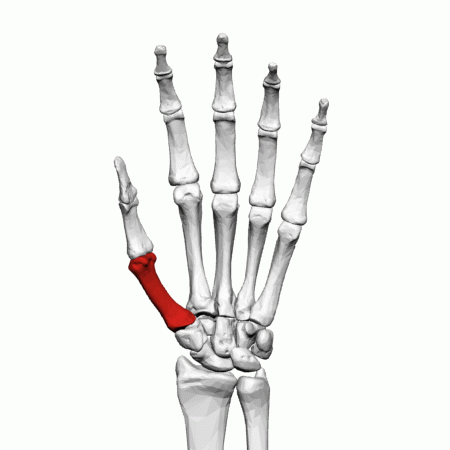The Two ways of Finger-use at the keyboard
This theory was developed prior to the acknowledgement of the tapping finger.
Most important of all is the fact that both these movements or exertions of the finger ("bent" or "flat") can be provided in two quite distinct ways with respect to how you apply energy using the muscles of the fingers. That is, you can produce the action of the finger either by:
- Exertion of its "small" (or weak) muscles only, or
- Exertion also of its "strong" (or large) muscles using a combination of the fingers, hand and forearm.
Keyboard Experiment
(a) Rest very lightly on a table with all five fingers and a loose-lying hand. Now repeatedly tap the table quite
lightly with one finger only and you will find, (provided you do this lightly enough) that you are now using only the
"small" muscles of the finger and you feel no action beyond the hand-knuckle (first phalanx and metacarpal bone).

(b) Now, instead, press considerably upon the table with the same finger, and notice the marked reaction at the wrist joint,
and at the first phalanx [1] and metacarpal bone also, which is almost driven up through the application of force downards. You are now using the "strong" musdes of the finger, and you can feel a momentary tension on the under side of the wrist.
It is this second way of exerting the finger which you must employ in sounding the notes.
Whereas the first way suffices to hold notes down once they are sounded.
1. Whenever you find your finger-passages "out of form" recall the experiment described above which described the two ways to apply energy using the finger.
1. Whenever you find your finger-passages "out of form" recall the experiment described above which described the two ways to apply energy using the finger.
The Second way of Finger-use needs Hand Exertion
When the finger is exerted in the second way (by its strong muscles), this demands a down-exertion of the hand each time the finger is used, as will be explained presently. Both ways also demand accurate adjustment of the forearm rotational-stress, as you will also realize later on.
Flexors and Extensors
The flexors and extensors of the forearm play an important role in piano playing. These muscles are responsible for controlling the movements of the fingers and wrist, which are essential for playing the piano. During piano playing, the flexor muscles of the forearm are used to flex the fingers and wrist, allowing the pianist to press down on the keys. The extensor muscles of the forearm, on the other hand, are used to extend the fingers and wrist, allowing the pianist to release the keys.
In order to play the piano with precision and accuracy, a pianist must coordinate the fingers, hand and forearm. This allows for greater control over finger and wrist movements, which is essential for playing complex pieces of music. Moreover, piano playing requires repetitive and sustained movements, which requires the correct application of energy of the forearm muscles. Regular stretching and conditioning exercises can help prevent injury and maintain muscle health, allowing pianists to play for longer periods of time with less risk of injury.
In order to play the piano with precision and accuracy, a pianist must coordinate the fingers, hand and forearm. This allows for greater control over finger and wrist movements, which is essential for playing complex pieces of music. Moreover, piano playing requires repetitive and sustained movements, which requires the correct application of energy of the forearm muscles. Regular stretching and conditioning exercises can help prevent injury and maintain muscle health, allowing pianists to play for longer periods of time with less risk of injury.
[1]
first phalanx: Each proximal phalanx is jointed to the metacarpal bone located in the palm, while each distal phalanx serves as the tip of a finger, as well as the home of the fingernail.